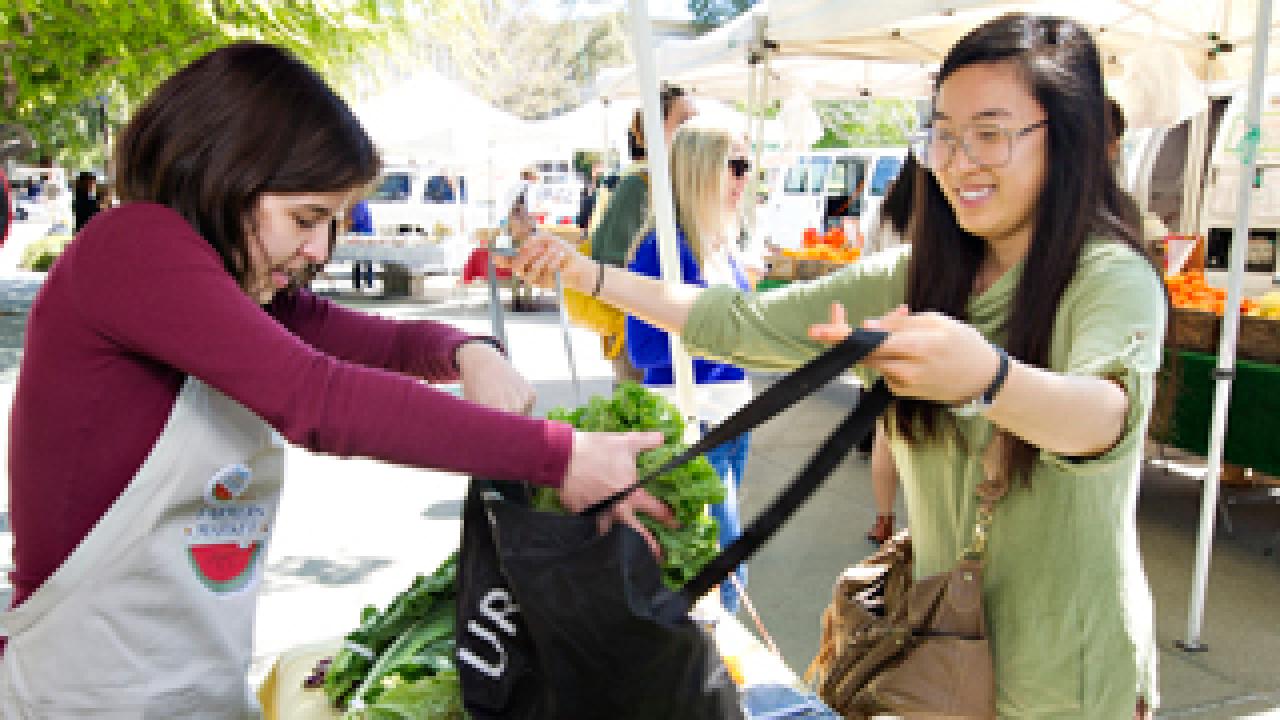Nearly 1,000 people actively working to green the campuses of California’s public and private institutions of higher education will gather at the University of California, Davis, this week for the 11th annual California Higher Education Sustainability Conference.
The conference, itself a zero-waste affair, will bring together representatives from more than 70 colleges and universities, primarily from California, from June 18 through 22.
A highlight of the conference will be the debut of “Ignite! The Art of Sustainability,” which launches a statewide traveling tour at the UC Davis Design Museum beginning June 18. The exhibit, which is free and open to the public, examines the human and natural forces that have shaped California’s landscape and includes work by UC Davis design professor Ann Savageau and professor emeritus Gyöngy Laky.
Conference participants from all four systems of higher education in California -- University of California, California State University, California Community Colleges, and private institutions -- will be sharing best practices in sustainability. Session topics, presented by a cross section of institutions, will include how campuses can build greener learning, living and athletics facilities; move toward zero net energy; create sustainable science laboratories; increase water efficiency in residence halls; and fill more campus dining plates with campus-grown food.
UC Davis has long served as a proving ground for innovations in environmental sustainability. This week, UC Davis became the first campus in the nation to introduce adaptive, networked exterior lighting, a project that will save $100,000 annually in electricity costs.
Other green achievements include:
- The university’s overall $39 million Smart Lighting Initiative is on track to reduce campus electrical use by 60 percent by 2015, saving $3 million on the annual electricity bill.
- Through its Climate Action Plan, the campus has reduced greenhouse gas emissions below year 2000 levels and expects to reach year 1990 levels by 2020.
- On an average weekday, more than 75 percent of students, faculty, staff and visitors use sustainable transportation (walking, bicycling, carpooling, riding a bus or taking a train) as their primary means of commuting to and getting around on campus.
- The campus has more than 42 miles of bike paths and more than 20,000 bike racks, earning it a gold award from the League of American Bicyclists.
- The student-run Unitrans bus system, a fleet of 49 buses fueled by compressed natural gas, carries 20,000 riders a day, serving the city of Davis as well as the campus.
- UC Davis is taking the principles of its arboretum -- ranked one of the 10 most beautiful gardens in the U.S. by Stylist Home -- to transition the 900-acre central campus into a public garden that features sustainable maintenance practices and native plants.
- Three UC Davis building complexes are certified LEED Platinum, the highest ranking awarded by the U.S. Green Building Council and more than any other University of California campus. One is the world’s first LEED Platinum winery and brewery, in which a new generation of students is learning to produce fine wine and beer using less water and electricity.
- Aggressive recycling, composting and reuse efforts prevent more than 60 percent of campus waste from entering landfills annually. Aggie Stadium has won the EPA’s Wastewise Game Day Challenge diversion rate championship for the past two years. In 2011, the stadium diverted more than 93 percent of its waste on challenge day. Throughout the year, the stadium prevents about 80 percent of its waste from entering landfills.
- The campus spends more than 20 percent of its $5.6 million food budget on local products, buys organic items such as poultry and grains, and sources olive oil and tomatoes from campus farms.
Perhaps most notably, the university last fall officially opened UC Davis West Village, the nation’s largest planned zero net energy community. Zero net energy means that in the course of a year, the 130-acre development will generate as much energy as it consumes. At build-out, the visionary public-private project will house 3,000 students, faculty and staff.
Sierra Magazine in 2011 ranked the university as one of the nation’s top 10 “Cool Schools.” Greenopia in 2010 also identified UC Davis as one of the country’s top 10 green campuses. And the Fiske Guide to Colleges in 2011 ranked the university among the top 10 environmental studies undergraduate degree programs.
All of this made UC Davis an obvious choice as a host for the conference, said conference event manager Katie Maynard from UC Santa Barbara. The 2012 conference marks the first time in seven years that the event has been held in Northern California.
“UC Davis was chosen because of how much work it’s already put into sustainability and how innovative that work is,” Maynard said. “Beyond biking, it’s the Unitrans student bus system and the providing of that transportation resource to the community. In terms of green building and green energy initiatives, the faculty has done so much to infuse sustainability into the curriculum. So UC Davis was in line with our conference values, but also pushed our values in a direction we wanted to see it go.”
Media Resources
Julia Ann Easley, General news (emphasis: business, K-12 outreach, education, law, government and student affairs), 530-752-8248, jaeasley@ucdavis.edu
Camille Kirk, Environmental Stewardship and Sustainability, (530) 752-7954, cmkirk@ucdavis.edu
